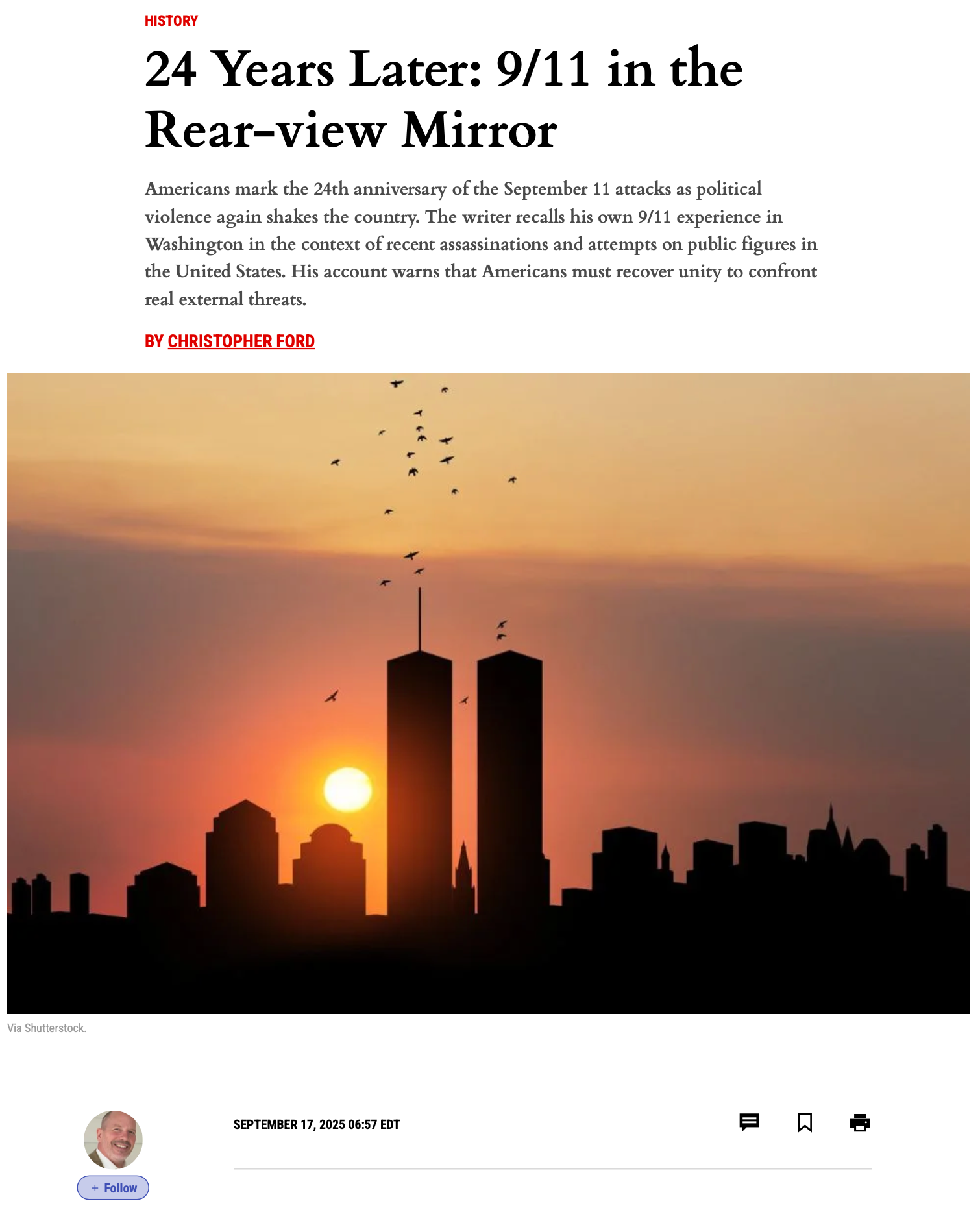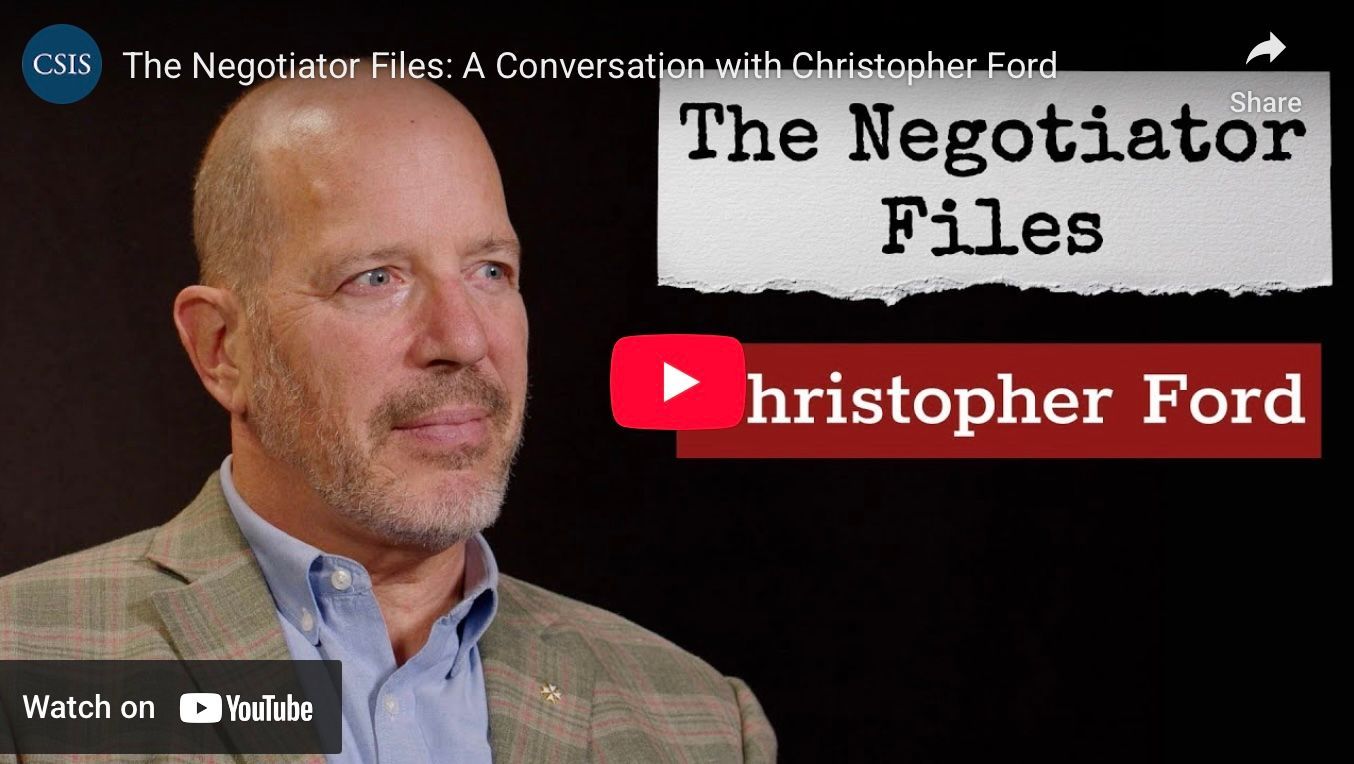Nuclear “Latency” and its Discontents
Below is the text upon which Dr. Ford based his remarks at the Woodrow Wilson International Center for Scholars on December 13, 2024.
The Good morning, and many thanks to the Los Alamos National Laboratory and our hosts here today at the Wilson Center for putting together this workshop on “latent” nuclear weapons status. I can only offer my own personal views, of course, and I won’t be speaking for anyone else, but it’s an important topic – and, alas, all too timely.
Nuclear “latency” is an interesting concept, but also a somewhat slippery one. I don’t doubt that it’s a real “thing,” for to some extent countries do appear to gain at least some deterrent capacity from being poised on that brink of weaponization. President Joe Biden, for instance, clearly is at least somewhat “deterred” by Iran’s near-weaponization status, and this has affected his decision-making in Iran’s favor – such as in his opposition to an Israeli strike upon Iranian nuclear facilities. (One can only hope Xi Jinping is similarly spooked by the idea of regional aggression in the Indo-Pacific in light of Japan’s possession of tons of separated plutonium and development of increasingly sophisticated longer-range strike systems.) But latency is a little tricky, so let’s explore it a little further.
The Ubiquitous Continuum of Nuclear “Latency”
Latency is a challenging concept because it is both a continuum and because it is ubiquitous. It exists along a continuum because we certainly worry more about a country that is more easily able to weaponize in short order than we do about one that isn’t. If there is indeed some kind of deterrent or coercive potential in latency, it is presumably conveyed in direct relation that vague quality of “closeness.”
Latency is also ubiquitous, because it is, in a sense, the baseline or “default” condition of life the nuclear era. I don’t just mean that it can be difficult clearly to identify clandestine nuclear weapons programs, though that’s true. Nor is it just that secret foreign assistance can help jump-start an illicit weapons effort – as, for instance, with the Soviets helping China build its nuclear weapons program in the 1950s, with China helping Pakistan do so in more recent decades, with former Soviet weapons scientist Vyacheslav Danilenko’s assistance to Iran, with North Korea’s work in constructing a secret plutonium-production reactor for Syria, and with the infamous network run for years by the Pakistani scientist A.Q. Khan that provided nuclear weapons-related know-how to Iran, North Korea, Libya, and perhaps others.
When I say that latency is in some sense the default condition of modern geopolitics, I also mean that, in theory, almost any reasonably sophisticated country could weaponize if it really wanted to. This has been particularly clear at least since inspections after the First Gulf War of 1991 revealed the surprising extent of Saddam Hussein’s prewar weapons program, but it’s a much older truth.
In fact, way back in 1946, at the very dawn of the nuclear age, the Acheson-Lilienthal Report recognized that any country hosting a peaceful nuclear power-generation facility was a potential proliferator, and that there was no way to entirely ensure against such seizure and diversion except by basically deterring it. According to the Report,
“[i]t is not thought that the [then-proposed] Atomic Development Authority could protect its plants by military force from the overwhelming power of the nation in which they are situated. Some United Nations military guard may be desirable. But at most, it could be little more than a token.
“The real protection will lie in the fact that if any nation seizes the plants or the stockpiles that are situated in its territory, other nations will have similar facilities and materials situated within their own borders so that the act of seizure need not place them at a disadvantage.”
That prescription basically amounted to a vision in which countries’ reciprocal nuclear latency deterred each other from weaponization. I’ll come back to this in a moment, but for now just remember this insight from back in 1946 that, at the end of the day, weaponization is something that must be deterred rather than just technically precluded.
Anyway, as long as nuclear technology exists and the know-how associated with weaponization cannot be erased from human minds, some degree of latency always will exist. If nuclear weapons can be built entirely from scratch once, they can be built from scratch again – and it would be vastly easier that second time because everyone now knows this is possible and many understand at least the basics of how to do it. As a result, true “irreversibility” – that fond but naïve dream of the disarmament community – is an illusion; some form of latency will always be with us.
Details Matter
But I don’t want to over-make the point. Clearly some situations of “latency” are more problematic and destabilizing than others. In practical terms, for instance, that vague concept of “closeness” I mentioned earlier is obviously very important. And also matters a lot about whom you’re talking. Details, as they say, matter.
We quite properly don’t worry much about Germany being part of the URENCO uranium enrichment consortium, for it is neither a source of geopolitical instability nor in any real way particularly “close” to weaponization. Yet we do worry a great deal about Iran’s nuclear capabilities, both because Tehran is now disturbingly close to weaponization and because the vicious clerical regime there has had already had an appallingly destabilizing impact upon the entire Middle East.
Nor, to make things more complex, is it quite beyond imagining that in some contexts, more nuclear latency might actually be a good thing. I wasn’t being entirely facetious a moment ago in wondering whether Xi Jinping might to some degree be deterred by Japan’s relatively advanced state of latency. Assuming that latency does provide at least some deterrent effect against aggression, under present-day circumstances of growing Chinese threats in the Indo-Pacific and worries about long-term U.S. alliance commitments, Tokyo’s nuclear latency is presumably preferable both to it not being a latent nuclear power at all and to seeing Japan engage in outright weaponization – just as such outright Japanese weaponization would itself be preferable to seeing China overawe, dominate, and absorb all of East Asia into Xi Jinping’s modernized Sinocentric version of Japan’s old imperialist “Greater East Asia Co-Prosperity Sphere.”
All this contextuality with regard to whether and the degree to which latency is actually a problem in the first place, however, makes thinking about these issues from an arms control and disarmament perspective quite complicated. Institutionally speaking, it’s hard to envision a really effective answer to such a broad, varying, and nuanced challenge.
Structural Challenges of the Modern Security Environment
Most of our existing nonproliferation institutions were built during the Cold War, in a very different strategic circumstances which, in some ways, helped ensure they worked particularly well. In the fairly rigid, dyadic, and alliance-structured world of the Cold War era, the two dominant players – the United States and the USSR – shared a keenly-perceived interest in nonproliferation. The nuclear-armed rival superpowers and alliance-block leaders both understood that even leaving aside broader challenges to international security from proliferation-driven instability, they had a strong and selfish interest in there not being more nuclear weapons possessors in the system.
In those years, nuclear latency was in a way itself less of an inherent problem, too. For one thing, the division much of the world into competing alliance blocks made it much easier to enforce nonproliferation values, for each alliance-leader had both an incentive and a wide array of tools with which to coerce latent nuclear powers within “its” alliance to refrain from weaponization. On top of that, in a world in which the two superpowers between them possessed more than 60,000 nuclear weapons, any other country’s mere latency probably seemed far less problematic and destabilizing than it does today. (Indeed, in the context of those astonishing numbers, even actual possession of an “entry-level” nuclear arsenal might arguably amount to no more than a rounding error.) This relative insignificance also presumably made latency less attractive to those who might seek it, for that context they would gain little advantage from it.
Ironically, however, the superpowers’ degree of disarmament since the end of the Cold War has made the problem of nuclear latency, and its potential relative strategic impact, much greater. Moreover, the world today is also far less dyadic and rigidly structured around alliance systems than it was before 1991. Both more multipolar and more informally organized than before, the contemporary world offers less opportunity for dominant actors to enforce nonproliferation restraint on their subservient allies.
The world’s current basic divisions, moreover – into an informal grouping of those generally devoted to preserving the existing rules-based international order, a gaggle of loosely coordinated authoritarian revisionists fiercely devoted to upending that order, and a broad collection of varied and disparate quasi-bystanders – also reduces the structural incentives all players may have to think that nonproliferation is actually in their strategic interest. Let me unpack this thought a bit further.
Global bipolarity during the Cold War seems to have been good for fighting proliferation and latency precisely because of its alliance-based rigidity and each bipole’s inherent incentive to prevent the emergence of new poles. Early post-Cold War unipolarity may also have been – in its own way – very good for nonproliferation, in that the dominant American “hyperpower” had both an incentive and the hegemonic means to help coerce others’ compliance with nonproliferation norms.
Rivalrous, unstructured multipolarity, however, has the potential to be much worse in terms of proliferation-related structural incentives. This is most obvious among the revisionists, of course, with both Russia and China seeming now to have drifted into what is essentially “pro-proliferation” territory in supporting Iran and North Korea against the West. If your geopolitical agenda is to dismantle U.S. global dominance and upend the existing international order, after all, even nuclear weapons proliferation itself – let alone mere latency – may feel like a good thing, or at least not a particularly bad one under the circumstances.
Nor, to be honest, does the potential problem in addressing latency lie only with those willfully disruptive revisionists. In the context of a sharply deteriorating security environment and an upsurge of harsh geopolitical rivalry in a more multipolar context, even free democracies wishing to defend themselves might come to find nuclear latency – or even proliferation itself – “thinkable,” or even desirable, to help meet threats from revisionist aggression at a time in which traditional alliances feel less reassuring than before.
Institutional Responses?
So what kind of institutional responses might we pursue to these challenges? Frankly, I fear there aren’t good institutional answers, for the effectiveness of international institutions tends to derive from the strength and coherence of the communities of nations that care enough to build them, live within them, maintain them, and enforce their strictures. Institutionalism faces great challenges in eras of multi-player rivalry and deliberately disruptive revisionism, and in such circumstances it is especially difficult to create new institutions.
But I do think that to some degree, we already have some of the key institutions needed to help grapple with the challenges of nuclear latency. We have control mechanisms such as the Nuclear Suppliers Group (NSG); we have an NPT Article II prohibition on nuclear weaponization and an Article III requirement for nuclear safeguards; we have International Atomic Energy Agency (IAEA) safeguards mechanisms; we have the IAEA Additional Protocol as a model of transparency and nuclear safeguards “best practices;” a number of countries now have national-level mechanisms for imposing and enforcing sanctions and other pressures against proliferators, and mechanisms for improved multilateral coordination as well. Defending these institutions and preserving their efficacy is very important.
We should also walk back the pernicious idea that every country has an NPT Article IV “right” to enrich uranium. The international community has made its latency problem much worse by not pushing back against – and indeed, in some quarters, by more or less coming to agree with – the narrative promoted by Iran and its apologists that under Article IV of the Nuclear Nonproliferation Treaty (NPT) every country actually has a “right” to produce fissile material if they wish. This is a problem I’ve been railing against for the better part of two decades, and condoning the mischievous “right to enrich” interpretation of Article IV has indeed helped “open the door to the incalculable dangers of a proliferated world.” So while we work to shore up the transparency and accountability mechanisms of the global nonproliferation regime, we should also repudiate the politicized legal narratives that make these challenges worse.
Nevertheless, on the whole, my instinct is that our main problem is less one of not having the right international institutions as much as it is of it having become vastly harder to use those that exist effectively in the current strategic environment. The clearest example of this is the U.N. Security Council itself, which for a brief while seemed well-positioned to impose pressures on countries that seemed to be rushing through latency toward weaponization (e.g., Iran) and to impose punishments on those who crossed the line (e.g., North Korea). One cannot imagine either Russia or China – both veto-wielding permanent members of the Council – allowing such things today, illustrating the fact that the problem now isn’t a lack of institutional mechanisms, but rather their paralysis.
Whether or not the transparency mechanisms of nuclear safeguards and inspections follow the Security Council into revisionist-paralyzed ineffectiveness remains to be seen. I certainly hope that they do not. But the fact of this paralysis helps point to what is surely the most important problem: the challenges created by the underlying security environment in which such institutions are embedded. In the current context, what the international community probably needs more than new institution-building is more effective stronger coordinated action by the global residuum of sensibly like-minded players to make latency and proliferation both as unattractive and as little needed as possible.
In the modern technological context, uranium enrichment and plutonium reprocessing are becoming ever more “accessible” – not to mention easier to conceal – while even the arcana of nuclear weapons design are probably also easier to master than ever before. Preventing proliferation is thus no longer primarily a “technical” problem of denying means and tools, but a “political” one of influencing policy decisions – either to prevent the emergence of nuclear latency in the first place, or to forestall movement from latency into weaponization.
We should of course continue to restrict the spread of the tools and means as much as we can, but the big lesson here is probably about the importance of influencing political and policy choices related to weaponization. And that means that the geopolitics of incentives and inducements – including, especially, those involved in deterrence – are at least as important to nonproliferation as are the more “technical” questions on which nonproliferation and arms control wonks usually spend their time.
A Return to Incentives – and Deterrence
And in that regard, we may still have something yet to learn from the Acheson-Lilienthal Report. As I flagged earlier, remember that the Report basically concluded that the most reliable way to manage the proliferation risks of the nuclear age was through deterrence. To be sure, what Acheson-Lilienthal had in mind was the deterrence created by multiple countries all knowing that if any one of them weaponized, others would weaponize in response. As I’ve discussed elsewhere, that sounds a lot like the “weaponless deterrence” ideas in Jonathan Schell’s 1984 book The Abolition, and I don’t think generalizing “virtual” deterrence is actually an approach likely to be stable and sustainable at “Zero.”
Nevertheless, it remains a powerful insight that deterrence is a more reliable tool in a divided and rivalrous world than clever treaties, conventions, and international institutions.
It may be, in other words, that the “best available” approach right now is simply getting as broad a range of players as possible to join us in coercive statecraft to discourage – and, if necessary, punish – destabilizing proliferation-related behavior, and to reward those who behave responsibly. Specifically, at the least, we need a twofold deterrence: we need to deter the pursuit of latency “closeness” by those whose status as a “virtual nuclear weapons state” would be most problematic, and we need to deter revisionist aggression enough to ensure that its would-be victims feel less need to develop latency (or even to weaponize) in response.
That may feel unsatisfying for an arms control and nonproliferation community that has grown accustomed in the post-Cold War era to thinking that there ought to be a treaty-negotiation answer to every geopolitical problem, but I think its honest wisdom. And I think it’s likely the best the world can do right now about the problem of latency.
— Christopher Ford







